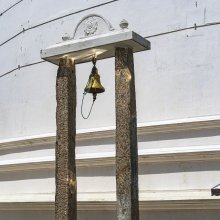Jin, Jiṉ: 3 definitions
Introduction:
Jin means something in Hinduism, Sanskrit, Hindi, biology, Tamil. If you want to know the exact meaning, history, etymology or English translation of this term then check out the descriptions on this page. Add your comment or reference to a book if you want to contribute to this summary article.
Jin has 4 English definitions available.
Images (photo gallery)
Languages of India and abroad
Sanskrit dictionary
[Deutsch Wörterbuch]
Source: Cologne Digital Sanskrit Dictionaries: Sanskrit-Wörterbuch in kürzerer FassungJin (जिन्):—, jinati (aus jyā , jināti) besiegen ; vgl. jinana. — Mit nis dass. (im Spiele) [Pañcadaṇḍacchattrabandha 20.]
Sanskrit, also spelled संस्कृतम् (saṃskṛtam), is an ancient language of India commonly seen as the grandmother of the Indo-European language family (even English!). Closely allied with Prakrit and Pali, Sanskrit is more exhaustive in both grammar and terms and has the most extensive collection of literature in the world, greatly surpassing its sister-languages Greek and Latin.
See also (Relevant definitions)
Starts with (+355): Jimdabad, Jimdagani, Jimdige, Jimdigi, Jimgare, Jimgha, Jimghana, Jimghana, Jimghia, Jimgisi, Jimjaragi, Jimjini, Jimjira, Jimjiri, Jimjirisamkale, Jimjita, Jimjitamgey, Jimkara, Jimkarisu, Jimke.
Ends with (+203): Abhigajjin, Abhigarjin, Abhojin, Aghabhojin, Agniprabhojin, Agnishtomayajin, Agramyabhojin, Ahaviryajin, Alajjin, Amrishtabhojin, Ananta somayajin, Anilavajin, Animantritabhojin, Anjin, Anusamvrijin, Anuvrajin, Apashubandhayajin, Arajin, Arunaparajin, Ashraddhabhojin.
Full-text (+129): Sarojin, Jins, Jincu, Hua tou jin jin xiang, Jin ma ti jin cao, Jin huang ce jin zhan hua, Xing mao jin jin xiang, Jin feng mao, Mao jin cai, Ma li jin, Jin si tao, Lidah jin, Jin shi, Ku mang huang jin, Jin zhi ci tong, Pu fu jin cai, Ai zi jin niu, San se jin, Lao niu jin, Jin ying gen.
Relevant text
Search found 22 books and stories containing Jin, Jiṉ; (plurals include: Jins, Jiṉs). You can also click to the full overview containing English textual excerpts. Below are direct links for the most relevant articles:
Jainism and Patanjali Yoga (Comparative Study) (by Deepak bagadia)
Ten rituals of the Temple < [Chapter 3 - Jain Philosophy and Practice]
Part 5.2 - Twelve additional Upangas < [Chapter 3 - Jain Philosophy and Practice]
Sukladhyana (pure meditation) < [Chapter 3 - Jain Philosophy and Practice]
Puranic encyclopaedia (by Vettam Mani)
Bhakti-rasamrta-sindhu (by Śrīla Rūpa Gosvāmī)
Verse 3.3.109 < [Part 3 - Fraternal Devotion (sakhya-rasa)]
Jain Remains of Ancient Bengal (by Shubha Majumder)
What is Jainism? < [Chapter 1 - Introduction and Scope of the Present Study]
The Fo-Sho-Hing-Tsan-King (A Life of Buddha) (by Samuel Beal)
Varga 7. Entering the Place (Wood) of Austerities < [Kiouen II]
Varga 13. Defeats Māra < [Kiouen III]
Varga 4. Putting Away Desire < [Kiouen I]
Bhesajjakkhandhaka (Chapter on Medicine) (by Hin-tak Sik)
Limitations of this thesis and future research directions < [Chapter 6 - Conclusion]
